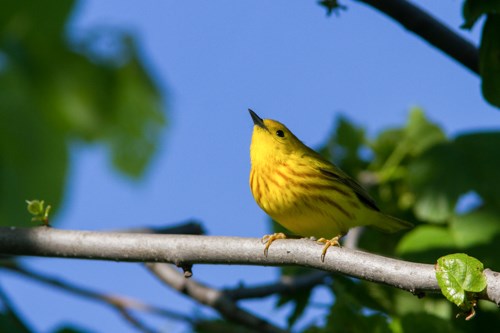
NPS/Gordon Dietzman IntroductionThis small, bright yellow bird is most often found flitting through river and lakeshore thickets and is among the favorites of birdwatchers. Unfortunately, the yellow warbler nests are a favorite target of cowbirds, which lay their eggs in the warblers' nests, leaving the yellow warbler to care for the cowbird's young. (Brown-headed cowbirds are obligate brood parasites. These birds followed the herds of bison that lived in the Midwest and their nomadic life didn't permit them to raise their own offspring. The solution was to lay their eggs in the nests of other birds and let the surrogate parents raise the cowbirds' young, while the adult cowbirds continued to follow the bison.) The large cowbird chick not only monopolizes the food brought back to the nest, but may also push the warbler's eggs or young out of the nest to further reduce competition. The yellow warbler, however, is not without its own defenses against brood parasitism. It often recognizes the foreign cowbird egg and isolates it by building a new nest liner over the top of it--as well as some of her own. She then lays a new clutch of eggs. In areas where cowbirds are common, yellow warbler nests have been found stacked six deep, each layer with at least one cowbird egg in it. This parasitic behavior on the part of the cowbird can have dramatic effects on populations of warblers and other bird species. Fortunately, the yellow warbler persists in the Mississippi National River and Recreation Area. Fascinating Facts
Identification
| |
Last updated: September 28, 2021
